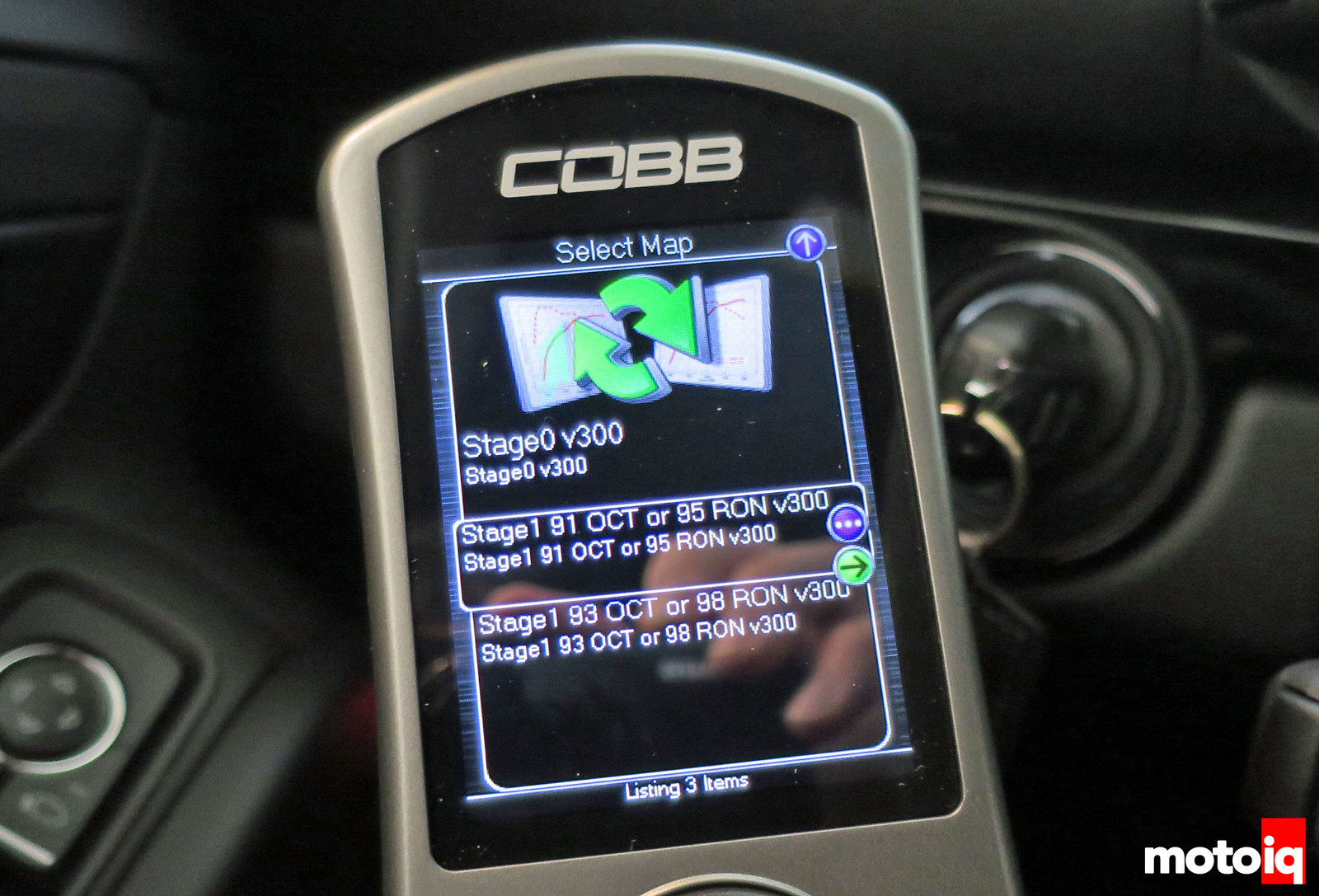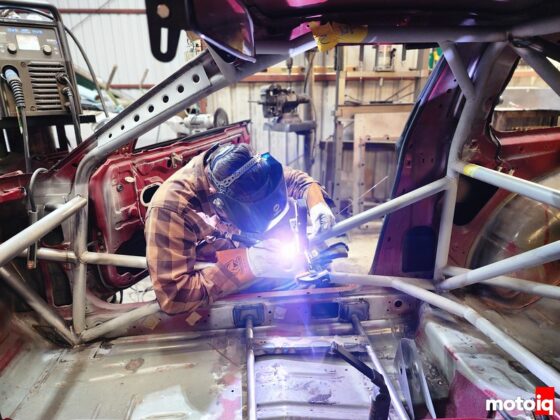The awesome thing about turbo cars is the ability to easily adjust the engine calibration for more power. Importantly for California, COBB provides off-the-shelf maps that have CARB EO numbers. Y’all know I like data and the COBB Accessport gives me datalogging ability of many parameters which I can plot in Excel to see how the engine is behaving. This data is important to check fuel quality and also guide future modifications for improved performance.
 Installing the Accessport the first-time sucks down a lot of battery juice as the process can take about 20 minutes, give or take. During the process, the Accessport will go into many of the different sections of the ECU which causes all kinds of lights and messages to cycle through on the dash; nothing to worry about. COBB recommends hooking up a 20A charger to make sure the battery voltage doesn’t get too low. If the voltage does drop too far and the install process is interrupted, I think it will brick the ECU. My charger is only rated at 6A, so what I did was hook it up prior to the installation of the Accessport and waited for the battery to be completely full. Per the convenient stickers on the car, the charger positive clamp is connected straight to the battery terminal, but the negative clamp is on a post near the strut tower; Porsche has the nice little brace going from the strut tower to the firewall right there. Yes, the yellow plastic strap thing is to hold up the big plastic cover. For subsequent flashes to upload new calibrations, those only take 1-2 minutes to complete, so a battery charger is not required. However, I do try to do those flashes soon after a drive so that the battery is topped off.
Installing the Accessport the first-time sucks down a lot of battery juice as the process can take about 20 minutes, give or take. During the process, the Accessport will go into many of the different sections of the ECU which causes all kinds of lights and messages to cycle through on the dash; nothing to worry about. COBB recommends hooking up a 20A charger to make sure the battery voltage doesn’t get too low. If the voltage does drop too far and the install process is interrupted, I think it will brick the ECU. My charger is only rated at 6A, so what I did was hook it up prior to the installation of the Accessport and waited for the battery to be completely full. Per the convenient stickers on the car, the charger positive clamp is connected straight to the battery terminal, but the negative clamp is on a post near the strut tower; Porsche has the nice little brace going from the strut tower to the firewall right there. Yes, the yellow plastic strap thing is to hold up the big plastic cover. For subsequent flashes to upload new calibrations, those only take 1-2 minutes to complete, so a battery charger is not required. However, I do try to do those flashes soon after a drive so that the battery is topped off.
 The all-important CARB EO number stickers for the off-the-shelf maps. In all caps on the Accessport is the warning to not accidentally turn off the car or disconnect the Accessport, or you will potentially brick the ECU. As y’all know, the stock Porsche calibration is tuned for 93 octane fuel, but we only get 91 octane in California. Fortunately, COBB has an OTS CARB approved 91 octane map. That said, fuel quality varies depending on brand, region, and time of year even, so I wanted a pair of custom maps.
The all-important CARB EO number stickers for the off-the-shelf maps. In all caps on the Accessport is the warning to not accidentally turn off the car or disconnect the Accessport, or you will potentially brick the ECU. As y’all know, the stock Porsche calibration is tuned for 93 octane fuel, but we only get 91 octane in California. Fortunately, COBB has an OTS CARB approved 91 octane map. That said, fuel quality varies depending on brand, region, and time of year even, so I wanted a pair of custom maps.
 In going with the COBB Accessport, you can get a protune from authorized tuners. I came across Alex from Stratified Auto a long time ago as I’ve caught his YouTube channel tuning VWs, Fords, and Subies. Then I caught some of his work on Rennlist doing a protune on a 991.2 Carrera with Vektor headers. He was able to extract more power with a custom tune with the headers whereas I had not seen any other tuner quantify the performance difference. Stratified Auto had a recent open house for their local PCA (Porsche Club of America) chapter. Thanks to Alex for the pictures!
In going with the COBB Accessport, you can get a protune from authorized tuners. I came across Alex from Stratified Auto a long time ago as I’ve caught his YouTube channel tuning VWs, Fords, and Subies. Then I caught some of his work on Rennlist doing a protune on a 991.2 Carrera with Vektor headers. He was able to extract more power with a custom tune with the headers whereas I had not seen any other tuner quantify the performance difference. Stratified Auto had a recent open house for their local PCA (Porsche Club of America) chapter. Thanks to Alex for the pictures!
 They have a shop 992 Carrera T they are developing; here is a link to the first YouTube episode. Airflow through the intercoolers is critical for dyno testing of course.
They have a shop 992 Carrera T they are developing; here is a link to the first YouTube episode. Airflow through the intercoolers is critical for dyno testing of course.
 The turbos of the base 992 Carrera are still pretty potent as shown by Stratified Auto after doing a protune.
The turbos of the base 992 Carrera are still pretty potent as shown by Stratified Auto after doing a protune.




5 comments
If not going stiffer on the suspension, consider a DSC controller. Made a world of difference for brake dive. Also more comfortable on the street and can now use the sport suspension setting on my local mountain roads which were previously too bumpy. Still imperfect with high frequency bumps but better than stock. I tried to go the fairly minimal route and did camber plates and toe arms on my T.
Yup, DSC is already in the plans! The all-out plans would be Tractive coilovers with 80/100 spring rates. We shall see.
It’s incredible the amount of information that is required to properly modify a modern ECU; and also very impressive that Cobb has managed to design the Accessport to handle all of the communication / data with a user-friendly interface .
I’m really impressed with the power output information the ECU can provide. It seems like not too long ago it took a piggyback or standalone ECU to have access to that same level of information.
It’s hot in there! Maybe a GT4RS style intake is in order?
Thanks for your hard work, professional insights and for sharing all this.
I look forward to reading your updates as I too have a CT.
For a pure track car, I’d look to implement a GT4RS style window intake, but it’s a bit too radical and loud for street use for me. The T is really exceptional out of the box. The bigger brakes and extra cooling are strictly due to my car doing double duty as a track car. For street use, the stock intercooler system is *mostly* okay. I wish the cooling fans would kick on sooner to bring the temps down after the car has heat soaked after sitting after a drive. The IAT heat soak is really a sustained high power use issue at the track and not a problem on the street. Hmm, I’ll have to ask Alex if there’s a parameter on how to better control the fans for the air to water intercooler system. It’s my understanding the APR tune turns on the fans sooner or more frequently, but no information on the actual Porsche control strategy. If you are willing to tune your car, that’s the only mod I would say is a no-brainer for a street car. Everything else I’m doing to the car is tweaking to the nth degree but definitely not required.